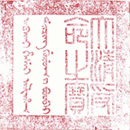
The Qing dynasty (1644-1911) with inscription in Chinese (left) and Manchu (right)
The role of seals in the Chinese culture can hardly be underestimated. For the last 3,000 years they have been used in both official and private spheres. The earliest examples of seals come from the Shang dynasty (c. 16th - 11th century BC) from the archeological sites at Anyang. However, very little is known about their usage at this early stage, it is only starting from the Spring and Autumn period (770-476BC) that we begin to see an increased quantity of seals paired with textual references to them. According to a Han dynasty story, the first seal was given to the Yellow Emperor by a yellow dragon with a chart on its back. Another story says that it was given to Emperor Yao by a phoenix as the emperor was sitting in a boat. In any case, the receipt of the seal signifies the conferral of the Mandate of Heaven. He who has the seal possesses the Mandate of Heaven, in other words, he has been given the right to rule the empire. So when Tang, the first ruler of the Shang dynasty overthrows the last tyrant of the previous Xia dynasty, he seizes the royal seal and thus establishes his power.
Imperial seals

Seal of the Handwriting of Emperor Qianlong (1736-1795)
Until the end of Warring States period (BCE 403-221), there was only one way of calling seals, both official and private, regardless of their use and material. This name was xi, which in the following periods gradually became the designation for imperial seals. According to the History of Tang dynasty, Empress Wu (634-705) issued an order to change the word xi, which was up until then used for imperial seals, to bao (treasure). Apparently, she disliked the fact that the word xi was close in sound to the si (death). But when Emperor Zhongzong resumed the throne in 705, he changed the name for imperial seals back to xi. In subsequent centuries the two words were alternated, depending on the period.
At the time of the Han dynasty, the emperor had six seals, during the Tang he had eight, during the Ming over a dozen, and by the time of the Qing, there were several dozens of official imperial seals. The inscription on these official seals usually refers to receiving the Mandate of Heaven or being the successor of Heaven.
Another type of imperial seal was a seal that the emperor used to indicate that a certain document was written in his own handwriting. Emperor Qianlong (1736-1795) for example, was famous for his literary ambitions, including calligraphy, and had produced a large amount of texts affixed with his seal. When his calligraphy was carved into stone steles, the seal was copied onto the surface of the stone too.
Yet another seal was used by the emperors to appraise and appreciate art. It was customary for collectors and connoisseurs of art to affix their seals on the surface of a scroll of painting or calligraphy. The paintings acquired by the imperial household were affixed by the imperial seal. Many famous paintings from the Forbidden City have seals of generations of subsequent emperors on them.










